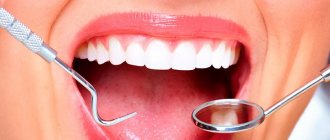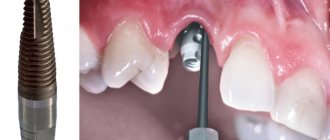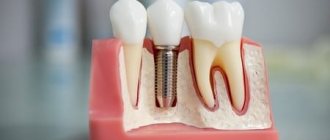After tooth extraction, the state of the dental system changes, the chewing load is redistributed, the bone tissue in the resulting gap is stabilized, and the hole is overgrown. All changes occur gradually, but over time the consequences manifest themselves in the form of bone atrophy, changes in the bite and subsidence of the gums. Is it possible to place an implant immediately after removal? Only an experienced specialist will answer the question, since it directly depends on the patient’s health condition. What implantation methods do modern dentistry offer and when can a dental implant be installed? Let's take a closer look.
When can a dental implant be placed after tooth extraction?
There are several methods for installing dental implants: two-stage, one-stage, one-stage. The latter is used immediately after tooth extraction. Its main difference is that the patient should have no contraindications for the operation, and the implantologist is fully prepared for the intended procedure. In practice, simultaneous implantation is rarely carried out, since most often they end up in the dentist’s chair too late, when the disease has progressed to an acute or chronic stage, severe pain has appeared and emergency removal is required. During a planned removal, the implantologist has from 2 to 14 days to prepare: collecting tests to identify contraindications, making casts of the jaw and a surgical template, selecting medications and creating a crown for the implant.
Main types of implantation
Valentina
When I decided to replace the old bridge with implants, I thought that the procedure was the same for everyone - they inserted an implant and put a prosthesis on it. But during the consultation I realized that this is really a whole science, an individual program is selected for everyone. So, for example, I was offered classical implantation. Now I’m waiting for complete engraftment, and I’m getting ready to use metal-ceramics. I hope this is forever!
Dmitriy
I had a classic implantation of one tooth. I am a supporter of proven and well-studied technologies, so I chose this option instead of the newfangled non-surgical implantation. I was afraid - it’s not a cheap idea, it’s better to do it “classically”.
Natalia
I wanted to get two classic implants, because my husband had them installed, and I like the result, but the doctors said that the bone was gone, and for the classic protocol it is necessary to do an implant first. I chose Amazing Price Dentistry, as a result, they planted bone material, did implantation, everything has already taken root and made impressions for the prosthesis. But what I want to say is that even with additional procedures, it cost me less than my husband, who fell for the offers of an expensive clinic.
Pros and cons of implantation immediately after tooth extraction
Unlike classic removable prosthetics, a dental implant has many advantages: 1. Natural pressure is applied to the bone tissue, comparable to the load on your own tooth root. For this reason, atrophy does not progress, the process slows down, and when choosing high-quality implants, changes do not affect the gums for more than 5 years; 2. Reliable fixation of the prosthesis in the mouth allows you to eat your usual food and perform oral hygiene using conventional means; the prosthesis does not interfere with diction, feels like one’s own tooth, without changing the patient’s usual lifestyle; 3. You can chew with dental implants installed immediately after tooth extraction, after their complete healing, just like with your own teeth. In terms of reliability, they are not inferior to conventional implants installed using other methods; 4. When installing an implant on the day of removal, bone tissue augmentation is not required or is minimal (bone material is added to the tooth socket during the operation). This approach significantly saves time for more complex bone augmentation operations (can take from 3 to 6 months); 5. The patient needs to visit the dentist less, both for diagnosis and for surgery and subsequent monitoring. Time is saved for travel and doctor appointments without loss of quality; 6. Neighboring teeth are preserved, since implantation does not require additional supports or preparation of other teeth. In the long term, this will save teeth from falling out and destruction; 7. The service life of a dental implant is from 8 to 15 years if it belongs to the economy class segment, from 10 to 20 years in the middle segment, and premium class implants last more than 20 years. Removable dentures require adjustment and replacement on average every 5 years, while the reliability of the fit is less due to changes in bone tissue.
Indications for removal
If you experience complications during or after implant treatment, then you should not panic right away - in many cases, the implant can be saved, but it is important not to waste time. Symptoms, after which you should immediately consult a doctor, as a rule, make themselves known very clearly. Most often, these are swelling, pain in the implantation area and fever. In most cases, such symptoms are associated with peri-implantitis, an inflammatory disease that affects soft and hard tissues. If the inflammatory process has affected only periodontal tissue, then the situation can be corrected with the help of antibiotics and rinses. In extreme cases, an incision is made in the gum, after which the damaged part is treated. If the inflammatory process has reached the bone, then the situation is much more complicated: when there is still a chance to save the implant, the doctor tries to eliminate the inflammatory process and may perform additional osteoplastic operations. If an x-ray confirms severe destruction of bone tissue and mobility of the implant is observed, then there is only one way out - removing the titanium root from the jaw.
How is the procedure done?
At the first stage, the patient visits the clinic for diagnostics. The blood is submitted to a laboratory for analysis; the analysis takes from one to several days. If you have your own diagnostic unit, the results can be known in a few hours. Afterwards an X-ray examination is carried out. To assess the condition of the jaw, a panoramic X-ray or computed tomography of the jaw is taken and the result is recorded on an information medium. If the patient goes to a third-party clinic or specialized center, the computed tomography scan is issued on a disk with the seal of the medical institution, signature and transcript of the specialist. Printing on film is rarely done, since electronic recording is more informative for the doctor. At the first appointment, the patient and dentist, having all the necessary data, discuss the expected result and which implantation options are most suitable for a particular patient. If during the examination no contraindications are identified, a treatment plan is drawn up that meets the patient’s wishes, then the dentist proceeds to the preparation stage.
In order for dental implantation to be successful immediately after removal, the dentist uses a computer model to predict the outcome of the operation. On the appointed day, the patient’s tooth is removed under anesthesia. An implant is placed in the socket, powdered bone material is added if necessary, and sutures are placed to close the operated area and stabilize the implant.
It is impossible to put a full load on an artificial tooth immediately after implantation, since primary stability can be disrupted. It is recommended not to overheat, hypothermia or physically overexert in the first week after surgery. In the first two months, it is recommended to follow a diet. Eat foods rich in vitamins and minerals, not spicy, salty or sour, as such foods irritate the mucous membrane.
The engraftment process takes from 4 to 6 months. After this time, the dentist will schedule a visit to determine the condition of the implant. When healing is complete, the crown is replaced. If the immediate loading technique was used, then initially a plastic crown is installed on the implant. This material is lighter and more aesthetic, and does not load the implant. But after six months of wearing it, it must be changed to ceramics, metal ceramics or zirconium. If a delayed loading protocol is used, a permanent crown is placed. It is fixed to the implant using an abutment after engraftment. The orthopedic stage completes the implantation process, after which the patient can chew and eat familiar foods.
After all procedures are completed, the patient must visit the dentist twice a year. This is necessary to preserve the implant and maintain stable oral health. During preventive examinations, the patient is recommended to undergo a hygienic teeth cleaning procedure. The plaque that forms in the oral cavity cannot be cleaned with a regular brush, even if all hygiene rules are followed. Professional cleaning helps prevent the accumulation of hard plaque around the implant, removes the yellow bacterial film, makes teeth naturally white, and eliminates microbes that cause gum inflammation. Gum disease directly affects the condition of the implant; in weakened gums, it becomes loose and falls out. Ultrasound cleaning reduces the risk of developing any periodontal diseases and improves the condition of teeth and gums.
Reasons for failed stabilization of the artificial root in the bone
Naturally, in case of unsuccessful osseointegration, the patient asks the dentist why the implant did not take root. The main reasons for this:
- Inflammatory process in the area of the installed root substitute. It can develop immediately after implantation or after several months. Provoking factors: non-compliance with doctor's instructions, smoking.
- An allergic reaction to the material from which the implant is made. Cases of allergy to titanium are rare and usually occur when rods made from alloys with a large number of impurities are used.
- Concealment by the patient of possible contraindications. If you have certain diseases or conditions, there is a high risk of implant failure.
- Medical error. Problems can be caused by the wrong choice of structures, their sizes, violation of installation technology, and insufficient sterility.
Is it painful to have implants installed?
Maria
I don’t think I was as afraid of giving birth as I was of getting implants. But still, the first process is longer and more painful. My implantologist got it done quite quickly (I timed it) - installation in about 20 minutes and another 15 minutes for preparation, talking about care, etc. During the procedure I did not feel anything other than pressure. After the anesthesia wore off, I took painkillers, tablet after tablet, for about 3 hours. After that, the discomfort could be easily tolerated.
Anton
It so happened that while I was about to place an implant on the chewing tooth on the right, a cyst formed under the root of the upper three, and the doctor said that I urgently needed to do a resection while there was a chance to save the tooth. This operation was performed under local anesthesia, and during it I understood what to expect from implantation. Everything is tolerable, it just starts to hurt - they add anesthetic. Therefore, I cannot say that it was painful.
Responsibilities of the surgeon
To avoid forced removal of implants, the surgeon must fulfill the following requirements:
- carefully prepare the oral cavity for surgery;
- diagnose all diseases that are included in the list of contraindications for implantation;
- if necessary, perform plastic surgery of the jawbone;
- impeccable adherence to the operation protocol;
- ensure absolute sterility of the oral cavity and surgical instruments;
- provide the patient with a complete list of recommendations for oral care during the rehabilitation period.
How to reduce the risk of implant failure
Implant failure cannot always be prevented. But you will significantly reduce this risk if you follow the recommendations of the implantologist during the rehabilitation period:
- The first visit to the implantologist is scheduled the day after the operation. The doctor examines the place where the artificial root is implanted and prescribes the necessary treatment.
- In the first days after implantation, it is important to carefully monitor your diet. Avoid hard and sticky foods, hot and cold foods. Alcohol should be completely avoided.
- Until the implant is completely implanted, strong physical activity, overheating or hypothermia of the body should not be allowed.
- Smoking increases the risk of developing rejection. You should give it up or reduce the number of cigarettes you smoke to a minimum.
- The implant should not be subjected to heavy loads. Be careful during hygiene procedures and eating.
You must take all medications prescribed by your doctor. Cold compresses can be used to relieve swelling.
Cost of implant installation
Egor
I’m writing, maybe the information will be useful to someone. My teeth fell out early and I didn’t want to walk with a denture. But I always thought that I couldn’t afford the cost of implanting ALL teeth. I was smart enough to go to a consultation, and there they explained to me, a complete idiot, that if all my teeth are missing, then I don’t need to get 32 implants. Enough 4 at the top and 4 at the bottom. And prostheses are firmly attached to them. It is much cheaper and quite adequate in cost. This design for one jaw can be ordered from 120 thousand.
Alina
My employee installed an implant in a “budget” clinic for 25 thousand, when I was puzzled by finding a good deal, I found it for 18. They did everything perfectly, the service not only pleased, but really delighted. Once again I was convinced that everyone’s budget is different!
PROMOTION
Osstem dental implantation turnkey
18,000 rub.
What it is?
Dental transplantation or transplantation is an operation in which a dental surgeon transplants an existing tooth germ or the tooth itself to the place where it is missing. Most often, this is autotransplantation of teeth - that is, the patient’s own teeth or their rudiments are used to restore a gap in the dentition.
The transplanted tooth germ develops in the new socket in the same way as its neighbors in their native sockets. Its root system grows into the jaw bone, so the nutrition of the tooth is no different from the nutrition of its neighbors. This ensures the reliability of the transplant result. As a result, such a tooth fully replaces the lost one. This technique is used for:
- congenital absence of a tooth, when the formation of a tooth germ has not occurred;
- tooth loss due to injury;
- removal due to deep caries;
- tooth extraction on the recommendation of an orthodontist, since some defects in tooth development can lead to malocclusion.
In addition to transplantation, there is a method of tooth reimplantation. The fundamental difference between them is that during reimplantation, the doctor first removes the tooth and then implants it in the same socket. Most often, this technique is used to eliminate a source of infection that cannot be eliminated by conservative therapy. A common feature of reimplantation and tooth transplantation is that it is important to preserve the integrity of the tooth and its roots.
What are the alternatives?
The most inexpensive way to replace a missing tooth is to install a removable butterfly denture. But it is quite noticeable from the outside, does not restore chewing function well and does not hold securely, so it should only be considered as a temporary solution to the problem.
Another common method is a bridge, which before the advent of implants was the most popular way to replace a lost tooth. The design consists of connected crowns - the outer ones rest on living teeth, and the central one fits tightly to the gum and closes the void. But to install this prosthesis, you will have to sacrifice two healthy adjacent teeth by grinding them down. And bone atrophy progresses under the prosthesis.
The most optimal alternative is dental implantation. This is the restoration of the crown of a tooth on an implant, which is fixedly installed inside the jawbone, exactly where the root of the living tooth was. However, this treatment will take longer compared to autotransplantation, especially if bone needs to be built up first.
1 Tsukiboshi M, Yamauchi N, Tsukiboshi Y. Long-term outcomes of autotransplantation of teeth: A case series. Dental Traumatology, 2019











